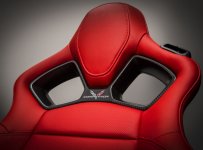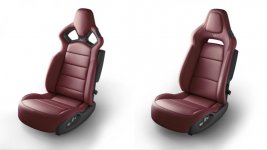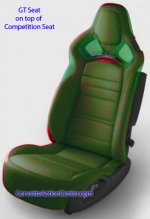- Admin
- #1
Corvette Seat Performance Proven Under Pressure
Customized test procedures used during development of Stingray’s new seats
2013-11-13
DETROIT – The differences in the Standard GT seat and the Competition Sport seat offered in the 2014 Chevrolet Corvette are similar to the everyday comfort of a well-tailored suit vs. the support offered by compression apparel athletes wear.
“Better seats topped our list for interior improvements, and we knew offering just one style would not cut it,” said Tadge Juechter, Corvette chief engineer. “Some Corvette drivers use the car for commutes, others as a grand tourer, and some drive it competitively. With two supportive seat options to choose from, drivers can pick the style that best suits their driving habits.”
Digital pressure-mapping, technology used to scan people’s backsides when seated, played a pivotal role in the development of the Corvette’s new Competition Sport seat, available as an option in December. Different seats last were offered in Corvette’s fourth generation – 1984-1996.
For the Competition Sport seat, the Corvette team took pressure-mapping technology to the test track to accurately measure driver bottom and back pressures during high velocity maneuvers. On most vehicle development programs pressure-mapping is only used for static impressions.
The technology involves taking a digital snapshot of a person’s back and rear-end pressure distribution over the seat surface, creating a map with more than 4,600 data points per second. The information is transferred to a computer that generates graphics illustrating how occupants are supported by the seat.
The new Corvette also was the first Chevrolet to use a new process for judging seat performance in addition to comfort, based on the subjective evaluations of test drivers of varying sizes, from large males to petite females.
For the new seats, the Corvette team used the advanced materials, including an all-new lightweight cast magnesium frame for greater strength. The frame’s rigidity and the seat’s hard back panel contribute to an enhanced feeling of support during performance driving.
The Sport seat was track tested and modified to provide the kind of bolster support needed for high-velocity maneuvers. The development team hand-modeled extreme bolsters out of duct tape and foam until they were satisfied with the seat’s track performance.
Back bolsters 35-mm deeper than those in the 997 generation Porsche Carrera S are approximately 35 percent deeper for more lateral support when making hairpin turns. The Corvette team also re-engineered the seat’s side airbag, moving it outside of the seat bolster to an attached but separate pod so that the seat could be slimmer, stiffer and more supportive.
While improving seat performance was a paramount concern, the team also boosted seat comfort by introducing Stingray’s first dual heating and cooling ventilation system for seats, overcoming packaging challenges in the process.
“While most Corvette drivers will find the GT seat perfectly comfortable and supportive, those who go to a track will appreciate the extra support offered by the Sport seat,” said Ryan Vaughan, design manager, performance car interiors. “They’re both a testament to the enormous amount of work that went into them. These are the best seats Corvette has ever had.”
About Chevrolet
Founded in 1911 in Detroit, Chevrolet is now one of the world’s largest car brands, doing business in more than 140 countries and selling more than 4.5 million cars and trucks a year. Chevrolet provides customers with fuel-efficient vehicles that feature spirited performance, expressive design, and high quality. More information on Chevrolet models can be found at www.chevrolet.com.
# # #

The 2014 Chevrolet Corvette’s optional Competition Sport seat was track tested and modified to provide the kind of bolster support needed for high-velocity maneuvers.

Digital pressure-mapping, technology used to scan people’s backsides when seated, played a pivotal role in the development of the seventh-generation Corvette’s new Competition Sport seat, available as an option in December.

The seventh-generation Corvette offers two seat options: The standard GT seat and the Competition Sport seat, available as an option in December. Corvette last offered different seat choices in the fourth-generation models from 1984 to 1996.
Customized test procedures used during development of Stingray’s new seats
2013-11-13
DETROIT – The differences in the Standard GT seat and the Competition Sport seat offered in the 2014 Chevrolet Corvette are similar to the everyday comfort of a well-tailored suit vs. the support offered by compression apparel athletes wear.
“Better seats topped our list for interior improvements, and we knew offering just one style would not cut it,” said Tadge Juechter, Corvette chief engineer. “Some Corvette drivers use the car for commutes, others as a grand tourer, and some drive it competitively. With two supportive seat options to choose from, drivers can pick the style that best suits their driving habits.”
Digital pressure-mapping, technology used to scan people’s backsides when seated, played a pivotal role in the development of the Corvette’s new Competition Sport seat, available as an option in December. Different seats last were offered in Corvette’s fourth generation – 1984-1996.
For the Competition Sport seat, the Corvette team took pressure-mapping technology to the test track to accurately measure driver bottom and back pressures during high velocity maneuvers. On most vehicle development programs pressure-mapping is only used for static impressions.
The technology involves taking a digital snapshot of a person’s back and rear-end pressure distribution over the seat surface, creating a map with more than 4,600 data points per second. The information is transferred to a computer that generates graphics illustrating how occupants are supported by the seat.
The new Corvette also was the first Chevrolet to use a new process for judging seat performance in addition to comfort, based on the subjective evaluations of test drivers of varying sizes, from large males to petite females.
For the new seats, the Corvette team used the advanced materials, including an all-new lightweight cast magnesium frame for greater strength. The frame’s rigidity and the seat’s hard back panel contribute to an enhanced feeling of support during performance driving.
The Sport seat was track tested and modified to provide the kind of bolster support needed for high-velocity maneuvers. The development team hand-modeled extreme bolsters out of duct tape and foam until they were satisfied with the seat’s track performance.
Back bolsters 35-mm deeper than those in the 997 generation Porsche Carrera S are approximately 35 percent deeper for more lateral support when making hairpin turns. The Corvette team also re-engineered the seat’s side airbag, moving it outside of the seat bolster to an attached but separate pod so that the seat could be slimmer, stiffer and more supportive.
While improving seat performance was a paramount concern, the team also boosted seat comfort by introducing Stingray’s first dual heating and cooling ventilation system for seats, overcoming packaging challenges in the process.
“While most Corvette drivers will find the GT seat perfectly comfortable and supportive, those who go to a track will appreciate the extra support offered by the Sport seat,” said Ryan Vaughan, design manager, performance car interiors. “They’re both a testament to the enormous amount of work that went into them. These are the best seats Corvette has ever had.”
About Chevrolet
Founded in 1911 in Detroit, Chevrolet is now one of the world’s largest car brands, doing business in more than 140 countries and selling more than 4.5 million cars and trucks a year. Chevrolet provides customers with fuel-efficient vehicles that feature spirited performance, expressive design, and high quality. More information on Chevrolet models can be found at www.chevrolet.com.
# # #
The 2014 Chevrolet Corvette’s optional Competition Sport seat was track tested and modified to provide the kind of bolster support needed for high-velocity maneuvers.
Digital pressure-mapping, technology used to scan people’s backsides when seated, played a pivotal role in the development of the seventh-generation Corvette’s new Competition Sport seat, available as an option in December.
The seventh-generation Corvette offers two seat options: The standard GT seat and the Competition Sport seat, available as an option in December. Corvette last offered different seat choices in the fourth-generation models from 1984 to 1996.








